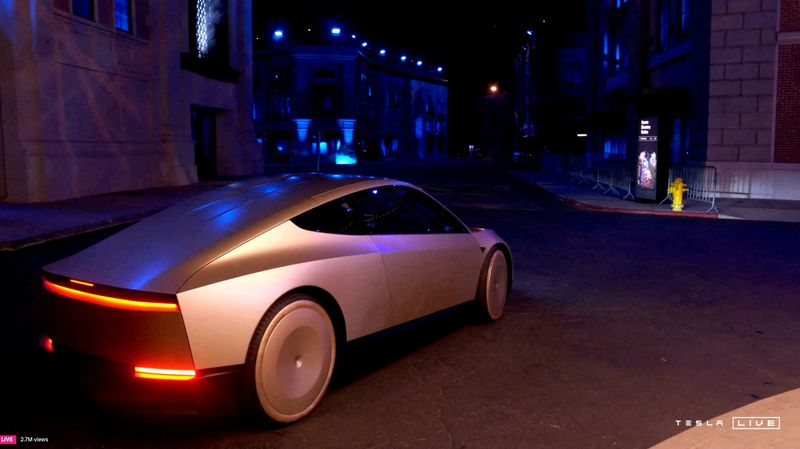By Chris Kirkham
LOS ANGELES (Reuters) -For a businessman who perpetually struggles with broken promises, Elon Musk gave himself quite a to-do list Thursday night at Tesla (NASDAQ:TSLA)'s long-awaited Hollywood unveiling of its driverless robotaxis.
His slew of announcements during a 20-minute presentation were short on practical details, which pushed the stock to close nearly 9% lower at $217.80 on Friday.
After traversing the fake streets of the Warner Bros movie studio set in a sleek, silver two-door "Cybercab" prototype, he promised that the company's popular Model 3 and Model Y vehicles would be able to operate without driver supervision in California and Texas by next year.
Musk said the company would start building the fully autonomous Cybercab by 2026 at a price of less than $30,000, and showed off a robovan capable of transporting 20 people around town - which he said would reshape cities by "turning parking lots into parks."
Later came the dancing humanoid robots that also mixed drinks at the bar, which Musk said Tesla will also eventually sell for $20,000 to $30,000 a piece. "I think this will be the biggest product ever, of any kind," he declared.
Thursday night's electronic dance music-infused event had the signature trappings of Musk's salesmanship, but some Tesla investors and experts said they were hoping for more concrete details on how the company plans to transform from an automaker into an autonomous driving and artificial intelligence titan with a solid business plan.
The stock, which has been pummeled since its record high in late 2021 by fears of cheaper EV rivals eating into Tesla's market share, is up over 30% since April, when Musk announced the shift to robotaxis. Still, shares are down nearly 16% over the past 12 months, compared with a nearly 33% increase in the broad-market S&P 500 index .
"His vision is lovely, but somebody has to actualize it," said Ross Gerber, a Tesla shareholder and CEO of Gerber Kawasaki Wealth and Investment Management. "For now, for the next 24 months, Tesla has to sell EVs. Why aren't we focused on that?"
Gerber said he was happy to see products like the Cybercab and the robovan, but hoped to also see a more traditional, lower-priced mass-market vehicle that the company could sell in the near future.
Musk had for years pledged to sell a car expected to start at about $25,000, a promise that investors saw as critical to winning new customers. Reuters reported exclusively on April 5 that Tesla had abandoned this project, initially sending Tesla shares down.
Shares of ride-hailing firms Uber and Lyft closed about 11% and 10% higher, respectively, as analysts said the lack of details on Tesla's robotaxis eased competition worries for the companies.
'YEARS BEHIND'
Tesla is aiming to leapfrog incumbent self-driving players, including Alphabet (NASDAQ:GOOGL)'s Waymo, by pursuing a lower-cost technological path that Musk believes will allow the company to scale up its autonomous vehicles far quicker than rivals.
Tesla's strategy is simpler and much cheaper than that of its rivals, but has critical weaknesses. Chief among those is that the AI technology underpinning its self-driving system makes it nearly impossible to pinpoint why a crash or other failure occurred - something that could concern regulators.
"Tesla software is at least years behind where Waymo is. That's the hard part. No flashy vehicle design is going to change that," said Matthew Wansley, professor at New York's Cardozo School of Law.
Tesla's rivals use similar AI and camera technology, but layer on so-called redundant systems and more-expensive sensors as a safety precaution.
Ramesh Poola, co-chief investment officer at Creative Planning, which holds Tesla shares, said he was impressed by the presentation but "obviously, we were looking for more details on what exactly his future plans are going to be and how he's going to monetize this new AI and robotics."
In particular, Poola said he anticipates regulators will pose a "major hurdle" to Musk's plans to shift to unsupervised autonomous driving by next year. Tesla's current "Full Self-Driving" driver-assistance feature cannot be operated safely without a human driver paying constant attention.
"He's shown the prototypes and definitely there's some excitement around it," Poola said. But widespread adoption of autonomous Cybercabs, where riders can hail rides through an Uber-style app, are still "maybe three to four years away," he said.
That is not necessarily a bad thing, Poola said, adding that he will be telling clients not to sell Tesla stock. "There are lots and lots of avenues to monetize this technology," he said. "Cybercab may not necessarily be next year, but down the road, the viability is there."
Musk had said he planned to operate a fleet of self-driving Tesla taxis that passengers can hail through an app. He made no mention of the app at Thursday's event.
Tasha Keeney, director of investment analysis at Tesla investor ARK Investment Management, said she had been hoping for more specifics on the app.

However, Keeney said she was encouraged by Musk's timeline of offering an unsupervised version of its full self-driving system in Texas and California next year.
"If they can do that, I don't see why they wouldn't launch a robotaxi service soon after," she said.